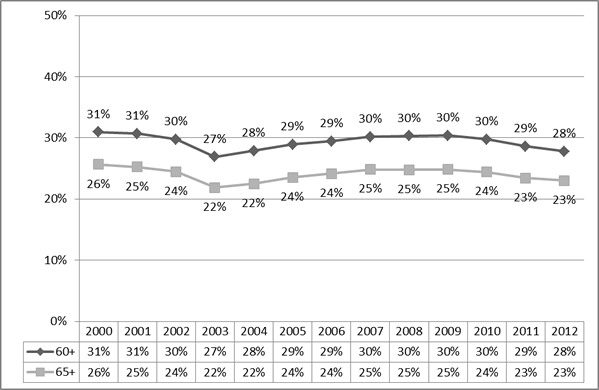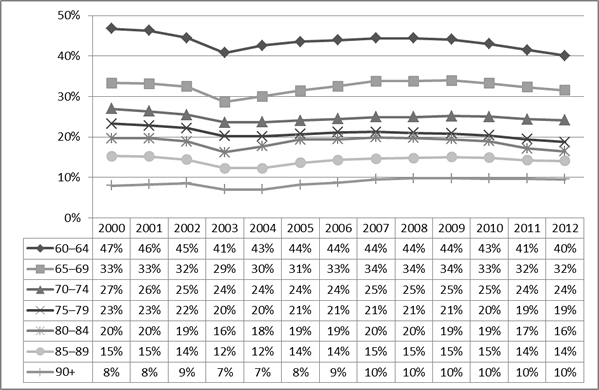Indicator 27: Medical insurance
| Indicator is fully reported? | Yes. |
| Type of indicator |  Outcome indicator Outcome indicator |
| Our findings |
Access to publicly funded health services All eligible older people have access to publicly funded health and disability services[1] and treatment and rehabilitation for personal injuries (funded by the Accident Compensation Corporation).[2] Eligibility criteria are set out in legislation and on government websites. Publicly funded hospital services are free to the user. However, people might pay a fee to visit a health professional (GP, nurse, or other health care worker) at their primary health care service. Some health and disability services are not publicly funded. They might be available privately or provided by charities. Individuals can take out private health insurance to cover expenses such as co-payments to attend primary health services, pharmaceutical expenses, diagnostic tests, specialists’ fees, dental and eye care, home nursing, and private hospital treatment. The main sort of service provided by both the private and public health sectors is elective (or scheduled) surgery.[3] Proportion of older people covered by private health insurance Health Funds Association of New Zealand (the Association) gave us data about the proportion of older people covered by private health insurance. We did not ask about the extent of cover held by each person. Figure 1 shows the proportion of older people holding private health insurance age 60+ and age 65+ from 2000-12. Figure 2 shows the same data in five-year age groups. Both graphs show that the proportion of people with private health insurance decreased during the period and decreases with age. The Association estimates that the proportion of older people with private health insurance will be about 20% or less by 2022. Barriers to access to publicly funded health services There can be various barriers to accessing primary health care services, including urgent services provided after usual business hours. Cost is a barrier relevant to this indicator. In 2011/12, participants in the New Zealand Health Survey were asked two questions about cost as a potential barrier to access.[4] The questions were:
The survey found that less than 10% of people aged 65+ reported that cost had prevented them from visiting a GP.[5] Less than 5% of people aged 65+ reported that cost had prevented them from visiting an after-hours service.[6] Cost was less likely to be a barrier for people aged 65+ than for all other age groups, except 15-17 year olds. The survey results are reported in plain English alongside the tables of data. This lets people review and use the data for their own purposes. They can also check whether they reach the same conclusion from the data. From 2014/15, "primary health system access" will be a Tier 1 statistics of the Official Statistics System. The indicator is in development.[7] See also our report for indicator 40, which discusses the accessibility of services to older people. |
| How entities use the data |
Holders of High Use Health Cards are entitled to pay reduced fees to their GP and reduced prescription fees. The cards lower the cost for people with ongoing medical conditions.[8] The Ministry of Health has a series of publications about trends in health expenditure in the public and private sectors.[9] The main purpose of the series is to provide information on expenditure in the health and disability sector. The Ministry of Health gives data to the OECD to use. The New Zealand Health Survey will be run every year. The Ministry says that this will enable it to monitor trends more effectively and regularly than in the past. |
| Entity responsible for this indicator |
The Ministry of Health and ACC are responsible for their respective legislation. The Health Funds Association of New Zealand collates private sector data. |
Figure 1: Proportion of older people with private health insurance age 60+ and 65+, 2000-12

Source: Health Funds Association of New Zealand, January 2013 using population estimates for June of each year from Statistics New Zealand. Figures rounded to the nearest percent.
Figure 2: Proportion of older people with private health insurance by five-year age group, 2000-12

Source: Health Funds Association of New Zealand, January 2013 using population estimates for June of each year from Statistics New Zealand. Figures rounded to the nearest percent.
[1] Ministry of Health (2011), Health and Disability Services Eligibility Direction 2011, www.health.govt.nz/new-zealand-health-system/eligibility-publicly-funded-health-services/eligibility-direction.
[2] ACC (12 March 2012), Am I covered?, www.acc.co.nz/making-a-claim/am-i-covered/ECI0002.
[3] We have audited progress made by district health boards and the Ministry of Health in delivering publicly funded scheduled services to patients. Our 2011 report is available at www.oag.govt.nz/2011/scheduled-services, and is called Progress in delivering publicly funded scheduled services to patients.
[4] Ministry of Health (2012), The Health of New Zealand Adults 2011/12: Key findings of the New Zealand Health Survey, Section 7: Barriers to Accessing Health Care, pages 93-111; see also Appendix 3 data tables, www.health.govt.nz/publication/health-new-zealand-adults-2011-12.
[5] The result for the 65-74 age group was 6.5% and for the 75+ age group was 4.2%.
[6] The result for the 65-74 age group was 3.4% and for the 75+ age group was 1.4%.
[7] Statistics New Zealand (16 October 2012), Tier 1 statistics 2012, www.statisphere.govt.nz.
[8] Information about the card, and an application form, is available from www.health.govt.nz/our-work/primary-health-care/primary-health-care-services-and-projects/high-use-health-card.
[9] www.health.govt.nz/publication/health-expenditure-trends-new-zealand-2000-2010.

